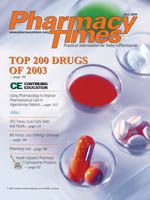Publication
Article
Pharmacy Times
Low-Carb Diets and Foods
Author(s):
Obesity is fast becoming America's number-1 health problem.According to recent figures, 64.5%, or about 127 millionpeople, are overweight. The incidence of obesity hasdoubled in the past 20 years.1 One expert blames this trendon a National Institutes of Health Conference in the mid-1980s that decreed that all Americans should reduce theirfat intake from 40% to 30% of their total daily calories.2 TheFood Guide Pyramid, released shortly thereafter, called for 6to 11 servings of bread, cereal, rice, and pasta daily, whilefats and oils were to be used "sparingly." American companiesbegan to introduce thousands of low-fat products full ofcarbohydrates as their answer to the call for sensible dieting.
The aftermath is that today approximately 45% of womenand 30% of men are attempting to lose weight. Inmany cases, dieting has become an obsession."Low-carbohydrate" rather than "low-fat"diets are now the latest craze. There areat least 14 popular diet plans. Withinthe past several months, a plethora of advertisements has appearedtouting their benefits. Pharmacists are certain to be asked about them.
The diets are the result of best-elling books written by Drs.Robert Atkins and Arthur Agatston, among others. Dr. Agatston has createdwhat he calls the South Beach Diet. It is somewhat similar to the dietproposed by Dr. Atkins. Both diets restrict carbohydrates—which means thatdieters must refrain from eating potatoes, bread, fruit, cereal, rice, pasta, beets, carrots, and cornfor the first 2 weeks. Alcohol also is forbidden in the inductionphase and is limited in the long-term diet. The SouthBeach Diet and some others distinguish between low- andhigh-sugar carbohydrates. Low-sugar carbs (those with a lowglycemic index) are permitted.
The Carbohydrate Dilemma
The problem with overconsuming refined or high-sugarcarbohydrates is that amylase, an enzyme, quickly convertsthem into glucose. This process causes the pancreas to overproduceinsulin, the substance that conducts glucose intothe cells. Unfortunately, excessive glucose is toxic to cells,and, after years of glucose and insulin overload, the cells canbecome insulin-resistant and may no longer allow insulin toeasily push glucose inside them. Blood glucose levelsbecome high, and in response the pancreas must make evenmore insulin in an attempt to insert glucose through cellmembranes.
High insulin and glucose levels eventually affect the pancreas,so that it can no longer produce insulin—and theresult is type 2 diabetes. The high levels of insulin and glucosealso increase the risk of coronary heart disease, hypertension,liver disease, polycystic ovary syndrome, and severaltypes of cancer.2
The Atkins Diet
Dr. Atkins' plan is the antipode of the food pyramid. It consistsof 4 phases. Phase 1 is Induction, and its purpose is toinduce weight loss by changing the body's chemistry toachieve lipolysis with secondary ketosis. The Atkins Diet seeksto change a person from a sugar-burning- to a fat-burning-for-energymachine. This phase is the most difficult, because it is designed to break down a person'saddiction to sugar, wheat, corn derivatives, alcohol, caffeine, and certain grains. Itlasts a minimum of 14 days.
Phase 2, termed Ongoing Weight Loss, is designed to establish a CriticalCarbohydrate Level for sustaining lost weight. This phase allowsthe dieter to begin eating certain fruits while controlling the consumptionof carbohydrates.
Phase 3 is the Pre-Maintenance period. This phase bridges losing andthen maintaining weight. Other foods may be added to the diet.
Phase 4 is called Maintenance. It begins when dieters have reached their goal weight.Certain foods still are forbidden, to prevent a return to the old eating habits.
The South Beach Diet
According to its Web site, the South Beach Diet is not classifiedas a low-carb or a low-fat diet. It teaches dieters toselect the right carbohydrates and fats and to eschew badones. The developer of the diet, Dr. Agatston, declares thatfollowers will lose between 8 and 13 pounds in the first 2weeks. Like the Atkins diet, this diet has phases, but only 3.
In Phase 1, the strictest phase, dieters can consume normal-size portions of meat, chicken, turkey, fish, and shellfish.In the first 14 days, as with the Atkins Diet, bread, rice,potatoes, pasta, fruit, and baked goods are taboo, as well ascandy, cake, cookies, ice cream, alcohol, and sugar.
In Phase 2, a more liberal phase, some carbohydrates are permitted, butin moderation. The proponents of this diet promise that people will continueto lose a pound or 2 a week on average.
In Phase 3, or the weight-maintenance phase, normal foods areallowed in normal-sized portions. Because Dr. Agatston is a cardiologist,he has said that this diet promises to alter blood chemistry and to benefitthe cardiovascular system.
Low-Carb Foods
Subway, Burger King, McDonald's, and other fast-food enterprises nowoffer low-carb foods. Grocery stores, health food stores, and many pharmaciesstock low-carbohydrate breads, pancake flours, cereals, and other offerings.Casual-dining restaurants, such as Ruby Tuesday and T.G.I. Fridays, recentlyhave added low-carb options to their menus. The option may be as simple ashaving a burger served in a wrap rather than on a bun. There are more than20 companies listed on the Web site synergydiet.com, selling everythingfrom soups to "gummy bears" candies.
More than 100 products now bear the Atkins trademark, each with a smallnumber or 0 g of net carbohydrates per serving. Breakfast bars, condiments,bakery items, cereals, and flours are available. Keto, for example, is a majormanufacturer of low-carb foods and snacks, including shakes, bread anddrink mixes, pastas, potatoes, fruit, desserts, and pizza dough. For the gourmetdiner, the potatoes, termed "Ketatoes," are available in 3 flavors.
Another popular product line is supplied by EAS. This company provideslow-carb nutritional shakes and energy and nutrition bars. Carboliteis another major supplier of low-carbohydrate foods. It specializes insnack foods, including chocolate bars, other candy, cereal bars, cookies, andmeal replacements.
Information for the Pharmacist
Because Americans are now obsessed with reducing carbs, pharmacists maybe asked to describe or define carbohydrates, the benefits of low-carb diets,glycemic index, and body mass index. Carbohydratesare defined as neutral compounds of carbon, hydrogen, and oxygen,mostly formed by green plants. Those that are highly processed, suchas sugar and white flour (the so-called "bad carbs") are digested too quickly.Thus, insulin levels suddenly rise, and individuals crave more food, usuallymore carbohydrates.
Low-carb diets induce weight loss bychanging body chemistry from a carbohydrate-burning metabolism to onethat primarily burns fat for energy. According to the Atkins Web site, thediet also is designed to stabilize blood sugar and to abruptly halt a myriad ofsymptoms indicative of unstable blood sugar, such as fatigue, moodswings, and "brain fog."3
Despite the popularity of the low-carbohydrate, high-protein, high-fatdiet, no randomized, controlled trials have evaluated its efficacy.4 This fact issurprising in light of the longevity of the Atkins Diet.5
Recently, a 1-year scientific study was conducted comparing the Atkinsdiet with a low-calorie, high-carbohydrate, low-fat (conventional) diet. TheAtkins diet (which initially limited carbohydrate intake to 20 g per day) produceda greater weight loss than did the conventional diet for the first 6months, but the differences were not significant at 1 year. The low-carbohydrate(Atkins) diet was associated with a greater improvement in some riskfactors for coronary heart disease, but, according to the study authors, longerand larger studies are required to determine the long-term safety andefficacy of the Atkins diet.6 The study was marred because large percentagesof patients were lost to follow-up.7
A longer study is planned comparing the Atkins diet with a conventionaldiet. Besides weight loss, lipid levels, bone density, and kidney functionalso will be measured.
The glycemic index measures how fast a food is likely to raise blood sugar.Glucose is given an arbitrary value of 100, and other carbs are given a numberrelative to glucose.
Body mass index is the accepted way of calculating whether or not a personis overweight or obese; 25-29.9 is considered overweight, and over 30 isobese. The index is calculated by dividing weight in kilograms by thesquare of height in meters. A number of Web sites contain information tofacilitate the calculation.
Final Thoughts
Pharmacists should know that "lowcarb" does not mean "low-calorie."Many dietitians believe that it is more important to count calories thangrams of carbohydrates.
According to the Pharmacist's Letter, both the Atkins and South Beach dietshelp some people by reducing food intake, and eating fats and protein reduceshunger.8 There are, however, no scientific data to verify long-termeffects. More information is needed to determine whether the beneficial effectsof the Atkins or a similar diet outweigh their potential adverse effects on therisk of coronary heart disease in obese patients. More balanced diets wouldappear to be preferable. The LEARN Program for Weight Management 9 and thedietary recommendations from the Department of Agriculture Food GuidePyramid 10 are good choices.
Obese patients should not expect any miracles. They should focus insteadon eating less, eating better food (ie, fruits, vegetables, fiber), and getting enough exercise.
Pharmacists should consider learning more about nutrition and becoming"diet advisers." A good way to start is to read Living the Low Carb Life, writtenby Jonny Bowden. It describes each of the 14 diets mentioned previouslyand provides a number of helpful Web sites.11
Mr. Sherman is president of Sherman Consulting Services Inc.
For a list of references, send a stamped, self-addressed envelope to:References Department, Attn. A. Stahl, Pharmacy Times, 241 Forsgate Drive,Jamesburg, NJ 08831; or send an e-mail request to: astahl@mwc.com.
Newsletter
Stay informed on drug updates, treatment guidelines, and pharmacy practice trends—subscribe to Pharmacy Times for weekly clinical insights.







